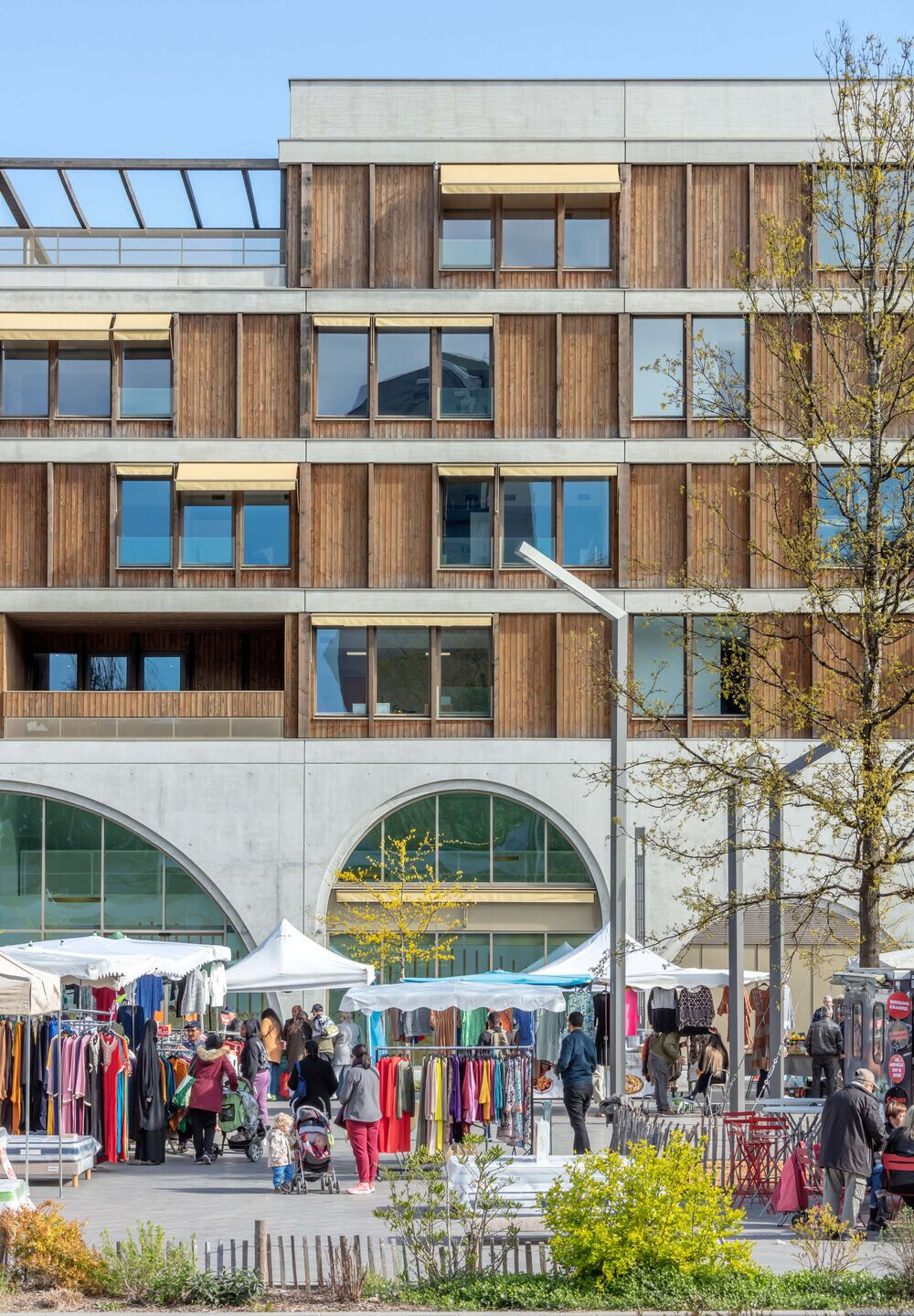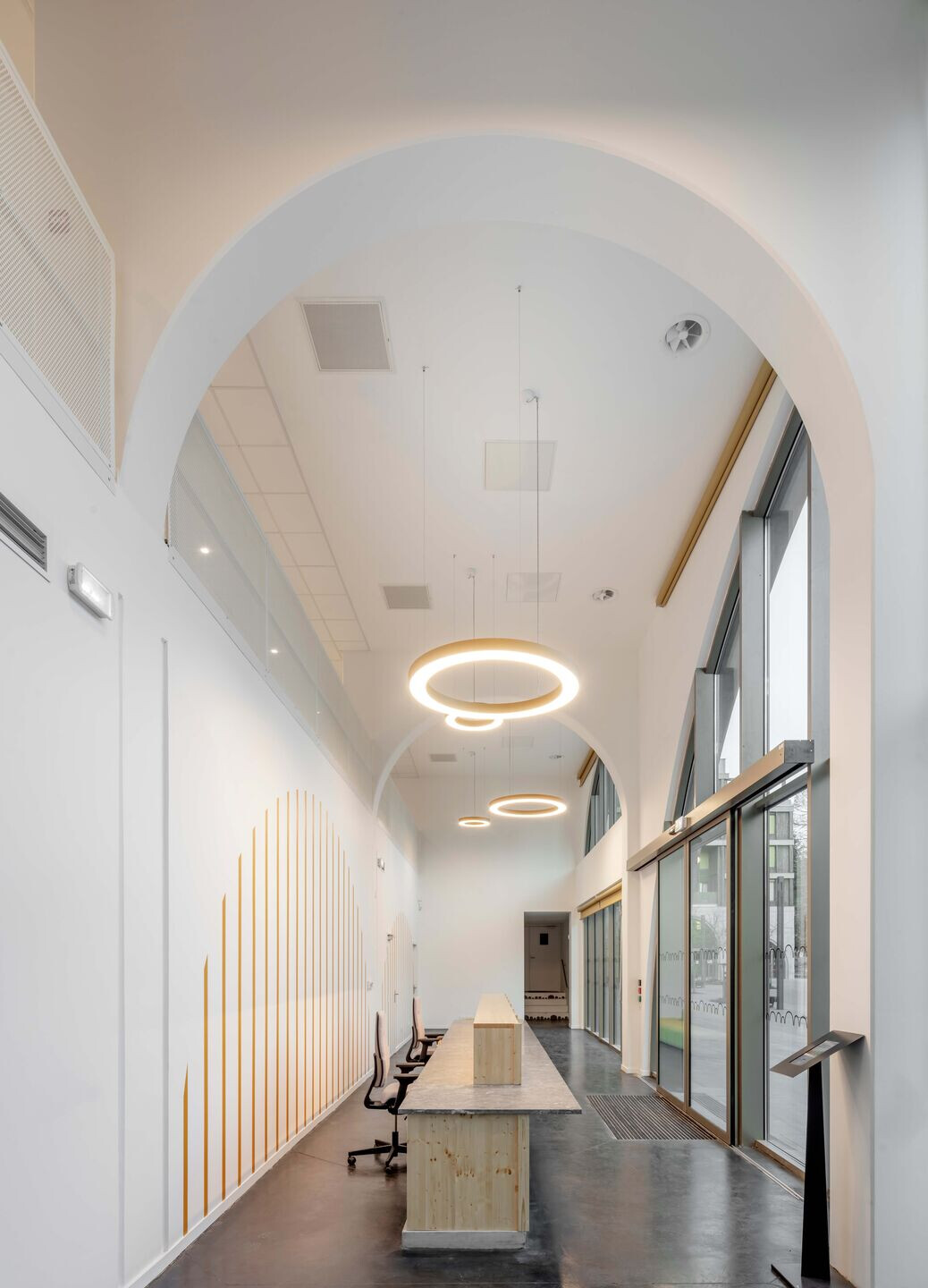On the Laherrère Square in Pau (France), in the heart of the Zaragoza district, CoBe’s architects, urban planners, landscapers, designers and site managers, in co-contracting with WEEK agency, just built two 11,210 m2 buildings of an ambitious program led by Pau Béarn Habitat.

Being at the same time a place of life, work, professional training and economic development, the Laherrère center contributes to the development of the Zaragoza district by creating a large offer of housing for students and young workers, office and training spaces, craft premises, as well as local shops and services.
Spread over two buildings, the project has a mixed materiality made of wood, concrete and glass, and is part of a global sustainable development approach combining bioclimatic design, bio-based materials, and energy performance.

A changing context
The construction of the Laherrère center is one of the priority axes of the urban renewal program of the Saragosse district. It is based on the general idea of creating two buildings: one to respond to the problem of housing for students and young workers and another for companies or associations mainly focusing on integration through employment, with services and shops on the ground floor.

Living in the square
The primary intention of the project was to constitute a real living space, on the model of a village square, like the market that the site has hosted since the beginning of the work.
The two L-shaped buildings, firmly anchored on Laherrère square, both adopt the same volumetry and the same materiality composed of wood and concrete.

Mixed program
Being at the same time a place of life, work, professional training and economic development, the Laherrère pole contributes to improving the living environment of the inhabitants of the Saragosse district and to meeting a maximum of needs.
The post and beam construction system put in place, in addition to its frugal dimension, makes it possible to accommodate a wide range of programs within the same project, and makes it possible to anticipate a possible evolution of this programming during the life of the building.

Thus the real estate complex includes:
• A housing hub with 116 student housing units managed by the CROUS (social organization for students) and 60 housing units for young workers managed by the Habitat Jeunes Pau Pyrénées association with shared common spaces, in connection with the professional training and integration activities present in the project.
• An entrepreneurial hub with office and coworking floors used in particular by associations, professional training structures and support for business creation such as the Cuisine Mode(s) d’Emploi school and its training restaurant founded by Michelin-starred chef Thierry Marx, the Simplon school and the 2nd chance school, as well as five craft premises.
• Local services and shops to meet the needs and expectations of residents such as a police station, services related to employment, a concierge, two breweries, and sales spaces related to craft premises. A “conviviality room” (multipurpose room) of 234 m2 also allows the organization of various events and is accessible by reservation to all the inhabitants of the project and the district.

Interior organization
Access to the floors is provided from the two halls via a common landing allowing access to the different programs. In the East Building, the common living spaces are accessible directly from the landings, and housing for students and young workers is developed on both sides via naturally lit hallways. In the West Building, the landings on each floor directly accommodate the break spaces and shared meeting rooms of the various work and professional training spaces. On the first floor, all the offices and common areas of the association Habitat Jeunes Pau Pyrénées are arranged by CoBe, by using second-hand office furniture, and through the realization of specific wooden furniture from reuse by a professional integration company.

The entire project attaches great importance to outdoor spaces, whether public or private. On the south side, the premises and halls located on the ground floor have direct access from the square, bringing life to the entire area, thanks to the breweries located at the corner of each building. Those also benefit from double- height spaces with mezzanines.

Quality of use
The Laherrère center project is primarily concerned with the integration of housing for young workers and student housing into an urban renewal project, linked with the professional integration activities which take place in the project. Its success is linked to the quality of the housing produced, as well as to the mix of uses offered by the global program. One does not go without the other. As such, common living spaces are shared between the two housing programs that the East Building hosts: shared entrance hall, furnished landings, laundry, coworking space, terraces...
The CROUS apartments are one-room of 17 m2 on average. The housing created for the landlord Habitat Jeunes Pau Pyrénées is intended to accommodate people from 16 to 30 years with various statuses with limited financial resources (employees, interns, apprentices, job seekers ...) The diversity of these accommodations allows the hosting of people wishing to live alone, as a couple, or in flatshare, as well as young parents. They are one-room of 17 m2 on average, one-room “prime” of 24m2, and one-room “bis” of 33m2.

Client: Pau Béarn Habitat
Design team: CoBe Architecture et Paysage (main architect)
WEEK (partner architect)
AIA (main engineer)
Gamba (acoustic engineer)
Program: Construction of two mixed buildings - East Building: Student residence of 116 rooms and young workers hostel of 60 rooms with shared common spaces and administrative premises (5050m2), restaurant (138m2), police station (202m2), cooking school with training restaurant (596m2), multipurpose room (234m2)
West Building: Office floors, coworking and professional training areas (3174m2), 5 craft premises (855m2), bakery (134m2), restaurant (154m2), services (562m2)
Missions CoBe: Architectural and landscape design, interior design, furniture prescription, building site management
Surface: 11 206m2
Completion: February 2023
Cos: 18 M€ HT
Photo credits: Luc Boegly







































